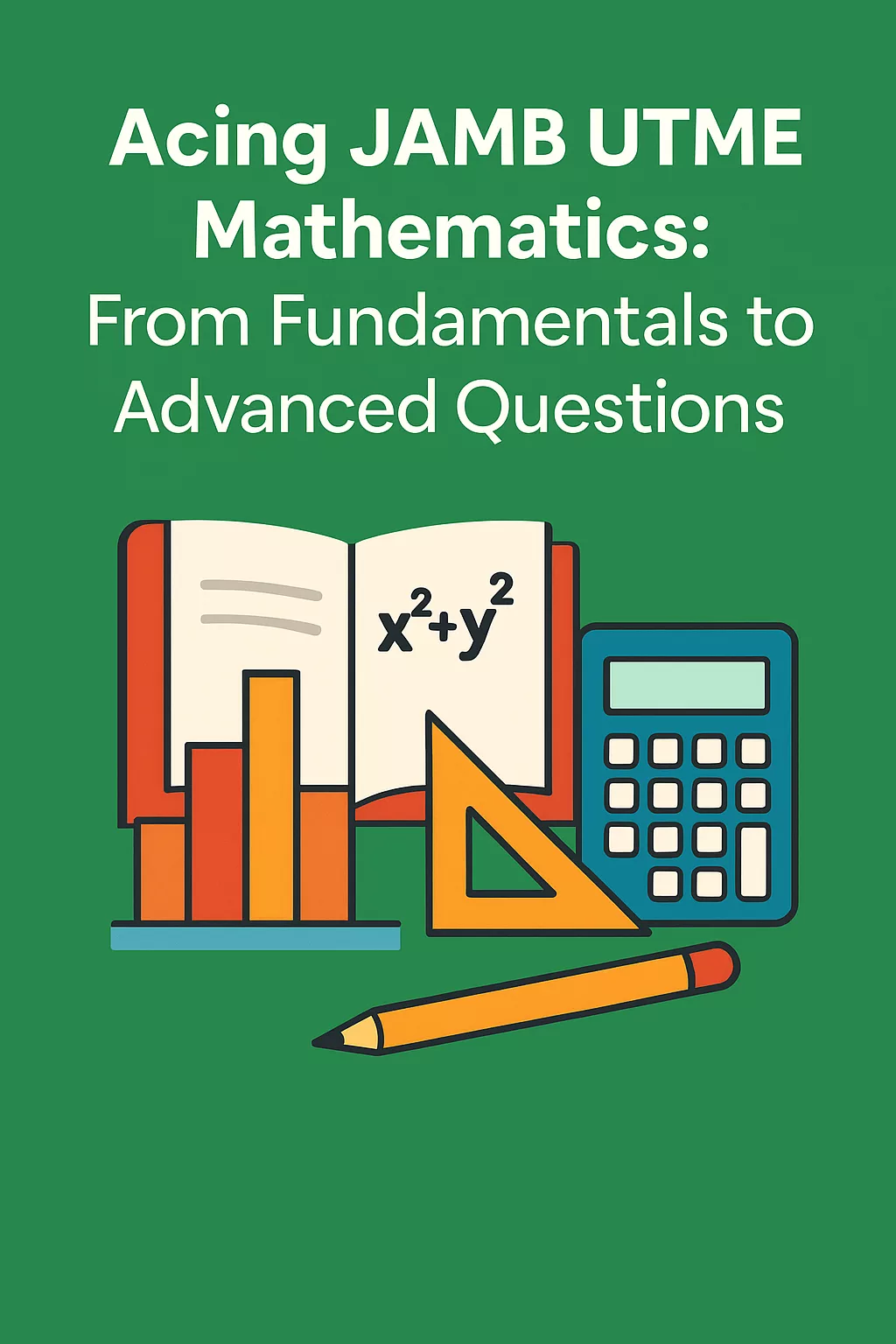1. Introduction
Mathematics remains one of the highest‑weight subjects in the UTME, often accounting for the bulk of aggregate scores for science and social‑science candidates alike. A firm grip on mathematical principles not only ensures strong performance in the 50‑question UTME paper but also lays groundwork for university courses in engineering, economics, and the sciences.
In this guide, we’ll map out a comprehensive roadmap: from reinforcing foundational concepts (number theory, algebra) through tackling more complex topics (trigonometry, coordinate geometry) to mastering exam‑specific techniques. We’ll unpack the exam format, illustrate problem‑solving frameworks, and offer targeted strategies to minimize errors and maximize speed.
By blending concept mastery with timed drills, you’ll sharpen both accuracy and efficiency. Whether you aim for a perfect score or to boost your overall aggregate, this article provides a step‑by‑step approach to elevate your mathematical prowess.
2. Deep Dive: Core Topics & Concept Breakdown
2.1 Number Theory & Arithmetic
- Integers & Divisibility: Prime factors, GCD, LCM applications.
- Sequences & Series: Arithmetic vs geometric progressions; formula derivations and sums.
- Ratios, Percentages & Proportions: Direct/inverse variation problems; mixture questions.
Practice Drill
- Compute the LCM of 12, 15, and 18 using prime factor trees.
- Find the 10th term of the AP: 3, 7, 11, … and its sum to n terms.
- Solve mixture: 60 L of 10% acid mixed with 40 L of 25% acid; find resulting concentration.
2.2 Algebra & Polynomials
- Equations & Inequalities: Linear, quadratic, simultaneous; graphical interpretations.
- Polynomials: Factor theorem, remainder theorem, roots and coefficients relationships.
- Logarithms & Exponentials: Laws, change of base, exponential growth/decay modelling.
Key Formulae Summary
| Topic | Principle | Formula/Rule |
|---|---|---|
| Quadratic Formula | Roots of ax² + bx + c = 0 | x = [–b ± √(b²–4ac)]/(2a) |
| Log‑Exp Relationship | Inverse functions | a^(log_a x) = x; log_a(a^x) = x |
2.3 Trigonometry & Geometry
- Trigonometric Ratios: Sine, cosine, tangent definitions on unit circle; identities (Pythagorean, angle‑sum).
- Radian vs Degree: Conversions; arc length and area of sector.
- Coordinate Geometry: Equation of line (slope‑intercept, two‑point), distance formula, circle equations.
Worked Example
Problem: Find the area of a sector with radius 5 cm and central angle 60° in radians.
Solution:
- Convert 60° to radians: π/3.
- Formula: A = (1/2)r²θ = ½×25×(π/3) = (25π/6) cm².
2.4 Statistics & Probability
- Descriptive Statistics: Mean, median, mode, range, standard deviation basics.
- Probability Basics: Mutually exclusive vs independent events; tree diagrams; conditional probability.
- Data Interpretation: Reading tables, bar charts, pie charts.
Quick Tip
Use complement rule P(A’) = 1 – P(A) to simplify complex probability questions.
3. Exam Strategy Tips
3.1 Time Allocation & Order
- Total Time: 60 minutes for 50 questions → ~1.2 min/question.
- Chunking: Start with your strongest topics to build confidence (e.g., algebra/trigonometry), then tackle harder ones.
- Buffer: Leave 5 minutes at end for review; flag tough questions to return.
3.2 Problem‑Solving Framework
- Read Carefully: Identify what’s given vs what’s required.
- Plan: Choose the right formula or theorem before manipulating.
- Execute: Show concise working; avoid copying large expressions.
- Verify: Check units, sign, and logical consistency.
3.3 Eliminating Wrong Answers
- Use estimation to rule out outliers.
- For quadratic problems, approximate roots to nearest integer and match options.
- In geometry, visualize or sketch diagrams to eliminate impossible answers.
3.4 Handling Complex Calculations
- Simplify radicals and fractions early.
- Factor common terms to reduce computation.
- Memorize key values (sin 30°, cos 60°, etc.) to avoid recalculations.
3.5 Anxiety Management
- Progressive Muscle Relaxation: Tense and relax hands before section.
- Positive Visualization: Recall a past success on a tough question.
- Pace Yourself: Don’t dwell more than 2 min on any one question.
4. Subject‑Specific Overview
4.1 Algebraic Insight
- Transformations: Practice mapping functions f(x) → f(x–h)+k to recognize graphs.
- Inequalities: Remember to flip inequality when multiplying/dividing by negatives.
4.2 Trigonometric Mastery
- Identities to Memorize: sin²θ + cos²θ = 1; tanθ = sinθ/cosθ.
- Compound Angles: sin(A±B), cos(A±B).
4.3 Geometry & Coordinate Applications
- Circle Theorems: Angles in a semicircle are right angles; cyclic quadrilaterals properties.
- Line Relations: Parallel lines → equal alternate interior angles.
4.4 Probability Shortcuts
- Complement Checking: P(A or B) = P(A) + P(B) – P(A and B).
- Permutations vs Combinations: nPr for ordered, nCr for unordered selections.
5. Practice & Resources
5.1 Recommended Textbooks
- Essential Mathematics for JAMB by Success Publications
- Comprehensive JAMB Practice: Mathematics by Regular Publishers
5.2 Online Resources
| Resource | Features | Access |
|---|---|---|
| Sumvision JAMB | Detailed video tutorials, quizzes | Free |
| Khan Academy | Foundational concept videos | Free |
| Physics & Math Tutor | Worksheets & solutions | Free/Paid |
5.3 Mobile Apps
- MyJambPrep: Customized quizzes based on weak areas.
- Math Ref: Formula index & solver.
5.4 Mock Exams
- Take 4 full‑length mocks at 2‑week intervals.
- Post‑exam analysis: Chart performance by topic; focus revisions accordingly.
6. Conclusion
Excellence in JAMB UTME Mathematics flows from a blend of conceptual clarity, strategic practice, and exam‑savvy techniques. By systematically mastering number theory, algebra, trigonometry, and data analysis paired with targeted mock drills and time‑management you’ll transform your approach from reactive problem‑solving to proactive scoring.
Commit to daily problem sets, track your error patterns, and engage with varied resources to reinforce weak spots. With persistence and the roadmap laid out here, hitting the 75+ mark and beyond is within your reach.
Start today: choose one topic, set a timed 20‑question quiz, and apply these methods. Your mathematical journey to JAMB success begins now.
